The 7 Best Men’s Ski Boots of 2023
Dotdash Meredith and Yahoo Inc. may earn commission or revenue on some items through the links below.
The Tecnica Cochise 110 Dyn Boot offers outstanding performance and full-day comfort.
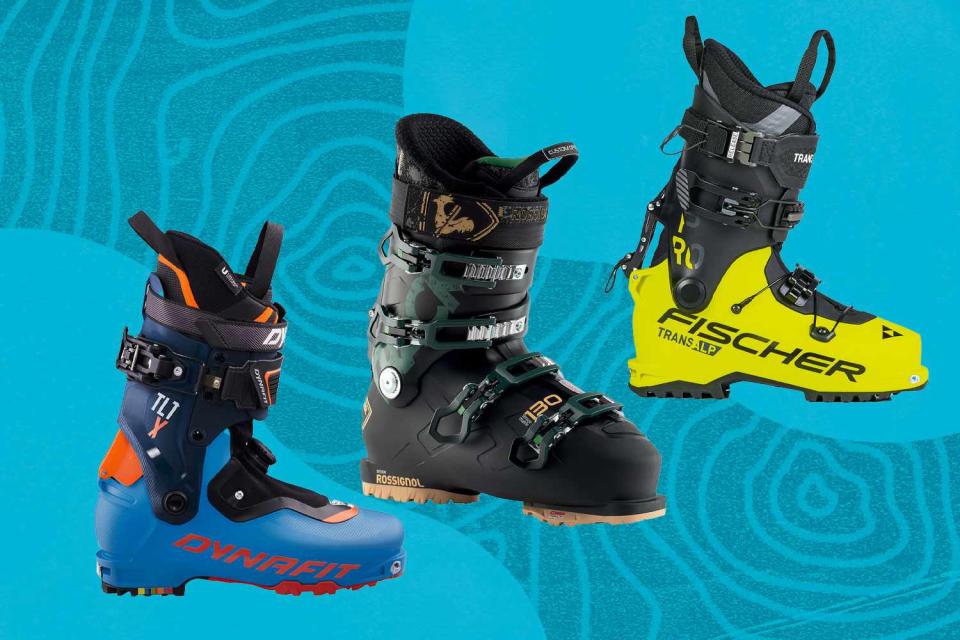
Travel and Leisure / Jaclyn Mastropasqua
Long days on the slopes, fresh mountain air, après afternoons that go into the night — what’s not to love about ski season? The challenge, however, is curating the right mix of gear, and no piece of equipment is more important than your ski boots. As some skiers say, you can date your skis, but you need to marry your boots. “Having the right pair of boots can really make or break your day on the mountain,” adds film director Katie Burrell of Revelstoke, British Columbia.
Finding the right ski boots can be more art than science. Prices vary wildly, and there are all sorts of technical specifications such as last, mondopoint, and flex that can be overwhelming for a ski-boot newcomer. Further, everything from your foot shape to your experience level and the types of terrain you'll take on should be taken into consideration.
We combed the market for seven of the best boot options, from wallet-friendly choices for first-time boot buyers to performance-focused pairs to last for many seasons to come. Top marks went to the Tecnica Cochise 110 Dyn Boot, a boot that packs comfort, performance, and a killer walk mode into a single boot, but you’ll find that each of these standouts have worthwhile attributes.
Tecnica Cochise 110 Dyn Alpine Touring Boot
Best Overall
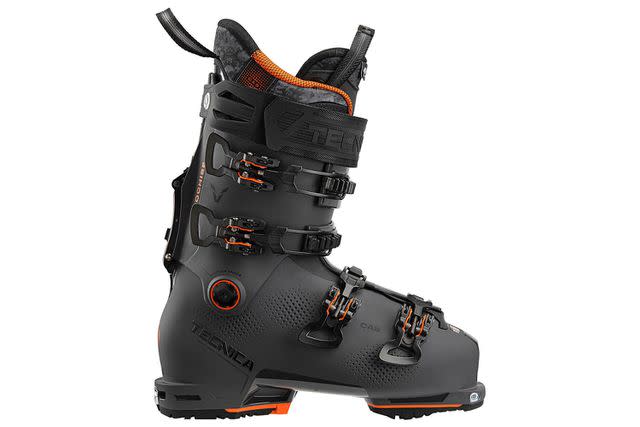
Why We Love It: It’s largely considered the best hybrid boot on the market thanks to a versatile mix of stability and comfort.
What to Consider: A 110 flex may be too stiff for beginners, and it’s technically a touring boot but works well for alpine skiing too.
This is the kind of boot that makes you question why you’d buy anything without a walk mode. Tecnica’s Cochise range offers a comfortable stride but still manages to capture all that power emanating from your ankles for the downhills. With a stiff 110 flex, it’s perhaps not the best boot for beginner skiers, but it’s a fantastic option for those who like to boot pack or hike terrain, as well as intermediate to advanced skiers who just want a more comfortable walk mode for long days in bounds at the resort. GripWalk soles make it easy to navigate complex terrain and icy parking lots alike.
“The Cochise is an excellent boot,” said Burrell. “I always like a boot that feels comfortable but is really supportive around the ankle because that’s where your power comes from.” And with a 99-millimeter last, this boot does exactly that. It has a four-buckle, two-piece design that offers reliable control, and a flexible shell that effectively keeps your momentum going from the summit all the way down to the lift line.
Price at time of publish: $600
Sizes: 26.5-31.5 | Last: 99 millimeters | Flex: 110 | Weight: 3.8 pounds
Dalbello DS MX 75 Ski Boots
Best Budget
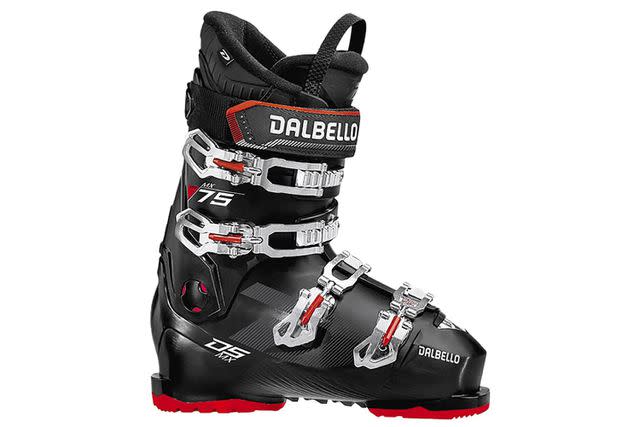
Why We Love It: With a spacious fit and flexibility, these are the perfect boot for those just getting into the skier lifestyle.
What to Consider: Skiers with narrow feet should avoid the Dalbello DS MX’s roomy 104-millimeter last.
Ski boots can easily cost several hundred dollars, so to find a quality, comfortable pair that comes in at this price is a veritable bargain. The Dalbello DS MX 75 has a cushy 104-millimeter last width — which makes it a great option for wider-footed skiers — so you can spend all day enjoying your turns on the slopes and not worrying about cramped or sore toes. These high-value boots still manage to be both lightweight so they won’t tire you out while walking around the base, and they transfer power smoothly as you carve your way down the mountain. However, if you’re an aggressive skier or on the heavier side, we recommend exploring boots with higher flexes.
Price at time of publish: $200
Sizes: 25.5-30.5 | Last: 104 millimeters | Flex: 75 | Weight: Not listed
K2 BFC 100 Men’s Ski Boots 2023
Most Comfortable
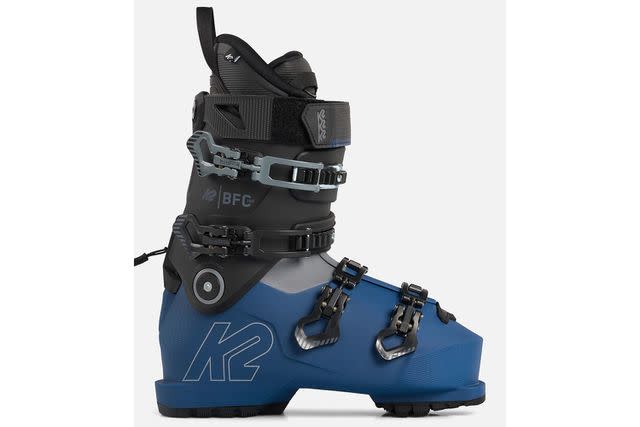
Why We Love It: A medium width and middle-of-the-road stiffness offer supreme all-day comfort.
What to Consider: They’re slightly heavy at 4.29 pounds, which intermediate and advanced skiers might find clunky.
The new and improved BFC 100 is made for those skiers who prioritize comfort but still need a boot that performs. A luscious Cushfit Plus liner made of EVA foam keeps your foot supported and snug without ever feeling tight, and a 103-millimeter last is comfortable and accommodates a cozy sock without sacrificing performance. A gracious 100 flex provides support for skilled skiing without getting into pro-level stiffness territory. They also come with an “Aprés Mode” walking setting so you don’t have to sacrifice mobility once you’re done skiing for the day. The BFC is also heat-moldable for a truly custom fit.
Price at time of publish: $450
Sizes: 24.5-30.5 | Last: 103 millimeters | Flex: 100 | Weight: 4.29 pounds
Related:
Salomon QST Access 70
Best for Beginners

Why We Love It: Balancing comfort and performance, it has the best of both worlds for everyday leisure skiers.
What to Consider: Your technique will probably eventually outgrow this boot, and it may be too wide for narrow feet.
When you learn to ski as an adult, pinpointing the right boot can be a challenging part of your journey. There are plenty of comfort-focused beginner boots out there (which tend to be pretty clunky) and seemingly infinite high-performing boots for advanced skiers (which quickly double or triple in price). So to find a solid performance boot that’s still comfortable but offers more performance than the most basic boots out there and comes in significantly less expensive than higher-end boots is certainly a find. The Salomon QST Access 70 manages to have the best of both worlds with pristine craftsmanship and comfort-promoting specs like a flexible feel and roomy width. It also comes with a CustomFit liner that offers great comfort and easy step-in, so you won’t be that person struggling to get their boots on in the lodge. The shell is made from polyolefin, a durable material that’s lightweight yet still stable.
Price at time of publish: $300
Sizes: 25.5-31.5 | Last: 104 millimeters | Flex: 70 | Weight: 3.7 pounds
Fischer Transalp Pro
Best for Backcountry Touring

Why We Love It: A lace-up liner and a range of widths provide a precise fit.
What to Consider: You can’t mix and match lengths and widths, and Fischer doesn’t provide an official flex rating.
Ski touring still feels like a niche, complicated sport — it requires even more ability and even more gear than traditional downhill skiing — but finding the right pair of touring boots is an excellent place to start. The Fischer Transalp Pro is what, as the name implies, the pros use. They combine outstanding stability and power transmission for your most thrilling descents, but are fantastically lightweight with a great touring mode for long, arduous ascents, too. Although there is no official flex listed, most skiers report a feel of around 120. The boot’s unique Power Buckle system and lasts that increase with the sizes ensure a performance fit, a full rubber sole helps you find your grip anywhere on the mountain, and a unique spring-loaded double-locking mechanism keeps the cuff of your boot liner and the shell securely connected, preventing accidental openings when you’re plowing through waist-deep powder. Sure, these will cost you — but it’s tough to think of a better touring boot on the market.
Price at time of publish: $950
Sizes: 22.5-30.5 | Last: 92-108 millimeters | Flex: Not listed | Weight: 2.82 pounds
Rossignol Track 130 GW
Best for Wide Feet

Why We Love It: It combines a relaxed fit with snugness at the heel to maintain power transfer.
What to Consider: If you don’t absolutely need a wider boot, these may compromise your technique.
A boot that’s too narrow can easily cramp your style and your feet. The Track 130 GW from Rossignol comes in a relaxed fit thanks to its 104-millimeter last width as well as a wider toe box and ankle area, but still has a snug heel pocket so even the widest-footed skiers can carve and shred with power. There’s also some softer plastic around the instep of the boot’s shell which allows for smooth entry and exit in addition to a hike mode that allows for an increased range of motion when you aren’t actively skiing downhill. If you’re someone with a wide foot that needs the accommodations of a wider boot, this is a great option; but if you have a normal-sized foot and you simply prefer a roomier ski boot, we might suggest you consider a different model.
Price at time of publish: $580
Sizes: 26.5-30.5 | Last: 104 millimeters | Flex: 130 | Weight: 4.2 pounds
Related:
Dynafit TLT X Boot
Best Lightweight
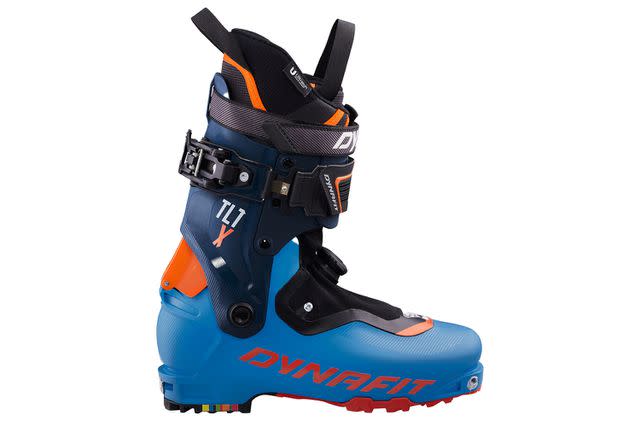
Why We Love It: A dial system over the instep allows for a quickly adjustable and precise fit.
What to Consider: It’s designed for touring, and may not have the necessary stiffness if you have a serious need for downhill speed.
We aren’t going to bury the lead here: the Dynafit TLT X weighs in at an astonishingly featherweight 2.27 pounds, roughly half of what other boots on the market might weigh. This comes into handy for two main scenarios: alpine skiers who plan on long (and we mean long) days on the slopes and don’t want to be weighed down by clunky boots, and ski tourers who need a lightweight boot for long uphill journeys. While it can be used purely as a downhill boot and has more downhill power than many touring boots on the market, it technically is a touring boot — meaning that it’s going to cost a bit more than a downhill-only boot and not provide race-ready stiffness.
Price at time of publish: $800
Sizes: 25-30.5 | Last: 101 millimeters | Flex: Not listed | Weight: 2.27 pounds
Tips for Buying Ski Boots
Understand the specs
There is a lot of jargon to sort through when it comes to understanding different ski boots, but it all boils down to two essential terms. The first is “flex.” This is the measure of how hard it is to flex your ankle while wearing the boot — and this is the key movement to help steer you through your turns. It’s worth noting that this is an approximate measurement that can vary wildly from brand to brand; a 120 boot in a Fischer may not flex the same way as a 120 boot from Rossignol. If it’s your first time buying ski boots or it’s been a long time since your last consultation, it’s worth visiting a ski boot-fitter in person to have them advise on your flex — it’s an approximate measurement that takes into account your ability and your body mass. Advanced skiers need stiffer boots that best transfer the force they apply to their skis, thus better - maintaining control at high speeds and providing maximum precision. However, this higher flex comes at the cost of comfort. Smaller and more beginner skiers should have lighter flexes in the 60 to 80 range, and expert skiers as well as larger individuals should generally have stiffer flexes in the 115+ range.
The other important term to understand is “last,” and this refers to the width of the actual molds that your ski boots were made on. A 99-millimeter width lasts for men tend to be on the snugger, more performance-oriented end of the spectrum, and 103- to 104-millimeters lasts are more comfortable and suitable for those with wider feet.
Prioritize comfort
When you’re sitting down in a store trying on ski boots, your foot is going to behave differently than when you’ve been pounding the powder all day in a frozen environment. Take into account that your feet are probably going to swell a bit from increased blood flow while you’re skiing and that you’ll also likely be wearing a thick sock, especially if it’s cold outside. While a ski boot should be snug and hug your foot — these aren’t your house slippers — it should in no way feel overly tight.
Consider replaceable insoles
Every foot is different, and adding a specialized insole can help piece the puzzle of your perfect boot together. There are literally hundreds of types of replaceable insoles out there to help you find the perfect fit for your ski boots. Some are flat for flat-footed people, some have arch supports for high-arched people, some are made from sustainably sourced materials, and others are electrified to offer a warming experience for those with cold feet. Make a decision about which ski boots work for you based on how they fit the length of your foot and around the top of your foot as well as over your ankle and up to your calf. Insoles can always be tweaked later on.
Don’t underestimate power straps
“I absolutely love a power strap,” said Burrell. “They basically allow you to take a comfortable boot and adjust the tightness and snugness for a more performance kind of fit.” That means that the strap going around the boot at the top just under the cuff can be your best friend if you’re looking for a boot that is both comfortable yet performs well.
Frequently Asked Questions
What size ski boots do I need?
<p>Ski boot sizing differs from that of your everyday footwear. They’re typically sized according to something called mondopoint, which measures your foot length from heel to toe and is best assessed by an expert in person. If your foot falls in between two sizes, you typically want to go to the next half size up; if your foot falls between 23 and 23.5 centimeters in length, for instance, go for the 23.5 size boot. Keep in mind that mondopoint sizing can still vary between brands, so a 24.5 boot in one brand may not fit exactly the same as a 24.5 boot in another brand.</p>
How should ski boots fit?
<p>Snug, but not tight. Your power on the slopes comes from how effectively the boot captures the energy moving through your ankles, so any gaps will create an inefficiency that will affect your experience on the slopes. You shouldn’t be able to fully curl your toes, but you should still be able to wiggle them.</p>
How do I put on ski boots?
<p>The first step is to undo all of your boots’ buckles. Next, pull the tongue of the boot liner forward a bit so as to create some space for your foot to enter the boot. Slide your foot in, and if you feel pressure or like you’re struggling to get the boot on, try standing up and pressing force straight down through your heels — that should cause your foot to slide neatly into place.</p>
How long do ski boots last?
<p>This is a topic of much debate in the ski community. Some gear lovers will update their ski boots every two or three winters depending on how often they use them, but other lifelong skiers allege that a good, well-fitting pair of boots can last for decades if properly cared for. Most manufacturers insist that you’ll get in the neighborhood of 200 to 250 skiable days out of your boots, at which point you should consider replacing them or at least updating the liner.</p>
How do I stay warm in ski boots?
<p>Staying warm in ski boots is not about piling on the thick socks — the secret is to make sure your feet have good circulation to keep your blood moving all the way through to your toes. For this reason, adding on unnecessarily thick socks thinking they will trap warmth may actually make your feet feel colder, as they will only serve to further inhibit circulation. Of course, it all begins with a well-fitting pair of boots — snug, but not tight. If cold feet are actually an issue, you might try buckling your buckles slightly looser than normal. If that doesn’t help, consider purchasing heated liners for your boots. They’re widely available these days and can be easily swapped into your existing boot shells.</p>
Why Trust Travel + Leisure
Todd Plummer is a travel writer and outdoors enthusiast living in Boston. He spoke to professional skiers, studied dozens of products, and drew upon his own years of experience as a skier to curate this list.
Related:
Love a great deal? Sign up for our T+L Recommends newsletter and we'll send you our favorite travel products each week.
For more Travel & Leisure news, make sure to sign up for our newsletter!
Read the original article on Travel & Leisure.

